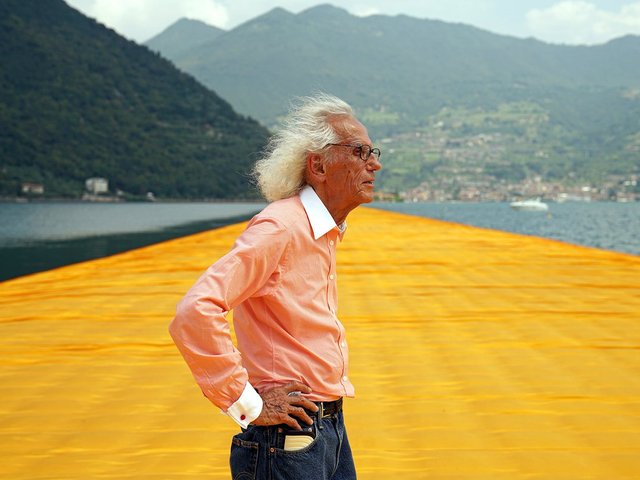Christo and Jeanne-Claude have been working together since 1961 when they made their first outdoor temporary wrapped work, Dockside Packages, Cologne Harbour, but it was only in 1994 that they officially merged into the artistic entity that is Christo and Jeanne-Claude. They are best known for wrapping public buildings—most notably Paris’s Pont Neuf (1985) and the Reichstag in Berlin (1995)—but in fact their projects involve the use of fabric in multifarious forms. The duo have punctuated New York’s Central Park with over 500 vinyl gates, run a row of curtains through Colorado, floated pink polypropylene around 11 islands in Florida’s Key Biscayne and their current work in progress, Over the River, aims to suspend a canopy of translucent reflective panels at eight points above a 40-mile stretch of the Arkansas River in South-Central Colorado. Not only was Christo’s work on show in five galleries at the first Art Basel, a year later in 1971 Annely Juda devoted its entire stand to his drawings and collages—the first solo show of an artist at the fair.
The Art Newspaper: When did you first realise you wanted to be an artist?
C: I was born in 1935 in Bulgaria. I had great parents: when I was six years old, my mother decided that instead of having piano lessons or learning a musical instrument, I should have private lessons in art. Three times a week I had a private tutor coming to my home, and I started to learn about art, making scale models, making sculpture, making paintings, drawings. So I have tried to be an artist since the age of six.
TAN: What was your first big break?
C: Bulgaria became a communist country and later there was the Hungarian Revolution in 1956. In January 1957 I escaped to the west—that chance to escape was probably my biggest breakthrough.
J-C: Christo was visiting Prague when the Hungarian revolution started and that gave him the opportunity to escape from Prague into Vienna. The revolution kept the Communists very busy at the Hungarian border and in the meantime some people had a chance to escape which is what Christo did.
C: I was 21 years old and I had a great desire to see more art outside my country as Bulgaria was entirely dominated by Socialist realism. I wanted to go to the west to see art—I knew a little bit from books—of course the desire was to go to Paris, because Paris at that time was the focal point for art. I was not speaking any western language except Russian and Bulgarian, I had no money or anything—I was a political refugee without a passport for 17 years! To avoid going into a refugee camp in Vienna I managed to enrol myself in the art school in Vienna and I did all kinds of jobs like washing cars and cleaning dishes in restaurants.
J-C: He was not so poor because, thanks to his training at the Art Academy in Vienna, he was able to survive by painting oil on canvas portraits which he was signing Javacheff, his family name. He painted a portrait of my mother in Paris in 1958, that was how we met.
TAN: What artists inspired you at that point?
C: Before I went to Paris I succeeded in going to Italy and probably the first great art I saw out of Bulgaria was classical Italian art. I still remember, as if it were yesterday, one of the greatest things was the Capella Degli Scrovegni in Padua.
J-C: We have been there, Christo and I, over 15 times.
TAN: What advice would you give now to a young artist starting out now?
J-C: We always give the same advice to the many young artists who come to us: if you are ready to work 17 hours a day and you absolutely give all your time, love, energy and money to your work and you are ready to do as Christo does today—his studio is, 45 years later, still on the 5th floor with no elevator—if you do all these things it will not be hard to do what you want to do. What is very hard is to know what you want—and then it’s easy, you do it!
Biography
Christo: b. Christo Javacheff, Gabrovo, Bulgaria, 1935; Jeanne-Claude: b. Jeanne-Claude Denat de Guillebon, Casablanca, 1935
1970: Annely Juda Fine Art; Galerie Ida Niggli; Omnash Galerie; Galerie Edith Tagente; Stolpeverlag Rosemarie Haas. 2009: Annely Juda Fine Art; Galerie Natalie Seroussi; Galerie Georg Nothelfer; Galleria Tega.
Originally appeared in The Art Newspaper Art Basel Daily as 'Our road to Basel 1970'


